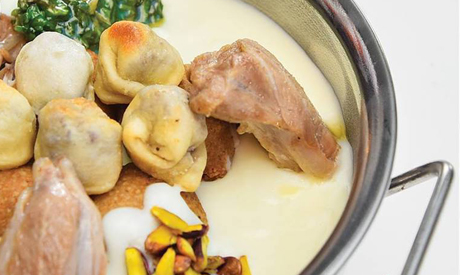
shakaria lahmeh (Taboon FB)
It started as a very small food stand in Zamalek, one of the most popular neighbourhoods for outings in Cairo.
Today, Taboon has expanded into the ground floor of a Zamalek apartment building overlooking the Nile – and along with the extra space, came extra items on what is now a much more elaborate menu that carries the brand of “urban Lebanese cuisine” but that offers several indisputably Syrian items.
The waiters are not really concerned with this very delicate – in fact almost politically sensitive – debate on whether a particular item on the menu is Lebanese or Syrian.
As far as they are concerned, the answer is: it’s good; and it can be ready in 20 minutes.
The dishes are described by the waitstaff as Levantine cuisine.
Of course, no Lebanese would ever settle down for the generic qualification of “Levantine” cuisine. That would hurt their culinary pride.
They would argue that: “yes, of course we share some items with them, but we do have our own cuisine and some of the items we share even have slightly different recipes.”
For a Syrian, what is the cuisine of “the Levant” if not Syrian? They would argue that with all the diversity coming from Aleppo, Damascus and elsewhere across the country is the origin, and this was later spread throughout Jordan, Palestine and Lebanon, who, the Syrian would acknowledge, do have their own specialities.
However, both the Syrian and the Lebanese, and for that matter a Jordanian and a Palestinian, would all agree that the mixed grill dish (mashawi), which is one of Taboon’s best and most popular dishes, is never a typical home-made lunch.
They would also agree that taboula is an uncontested Lebanese salad that most Egyptian restaurants, Taboon included, fail to dice or season the way it is done in Lebanon.
There could be a debate, however, on whether shakriya (a dish of half-fried and half-stewed lamb covered with a thick yogurt-based sauce) is the original Syrian recipe from which the Lebanese laban imoh – minus a few elements of the sauce recipe – is derived, or whether it is the other way round.
That said, they would agree that if a restaurant calls itself Lebanese it should rather go by laban imoh than shakriya as the name for a dish that is quite good but is not done to the standards of the flavour of a shakriya served in a Damascus house or a laban imoh served in even a basic Beirut restaurant.
This debate is hardly possible if the dinning group are mostly Egyptian, with no real experience of indulging in the many delights of the cuisines of Syria and Lebanon.
The focus would rather be on other aspects: the food is not at all too heavy; the portions are adequate; the main dishes are much better than the starters – and the hot mezza are better than the cold selections of mezza.
When it comes to the dessert section, the options are not very varied but whatever is offered is quite good and it is usually enough to order three items to share for six people, to be followed by refreshing mint tea, and for those who absolutely adore it, shisha, both outdoor, on the little pavement space that Taboon has.
Indoor seating is also an option.
Taboon does not stand at the inexpensive end of the café-bistro market (it is not exactly a restaurant in terms of setting, despite a restaurant-oriented menu that also has a very inviting ideas for a late Friday breakfast or a Saturday brunch).
Dinner, drinks and shisha for two people could cost around EGP 800.
The restaurant is located on Abul-Feda Street and it is open almost 24 hours a day. It also has an efficient delivery service, with food arriving warm and neatly packed
Short link: